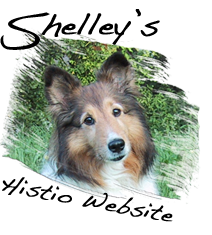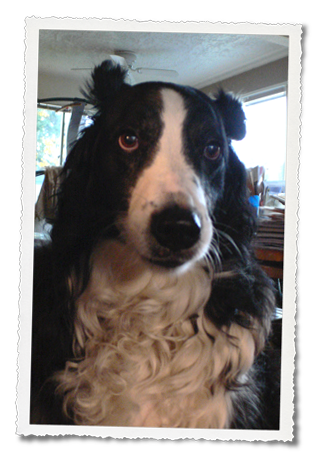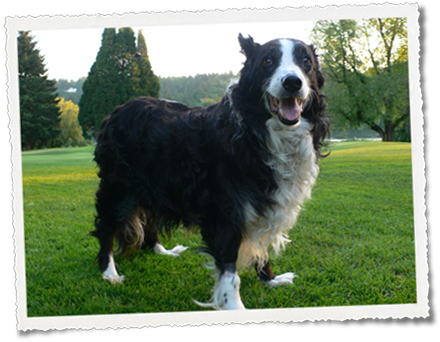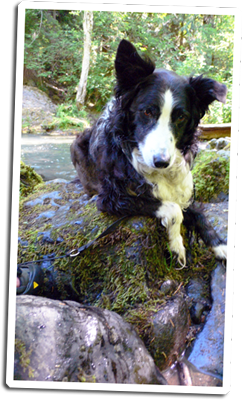
HOME
 YOUR HISTIO STORY
YOUR HISTIO STORY
I am looking for similarities
in all individual cases of
Histiocytic diseases.
I wonder if we all tell our
stories we might come up
with some commonality
between the specific
situations in which all of
our pets got this disease.
So please email me the
details and I'll put your
pets story on Shelley's
Histio Website
 UW HISTIO VERHAAL
UW HISTIO VERHAAL
Ik ben op zoek naar
overeenkomsten in alle
individuele gevallen van
Histiocytose.
Ik hoop dat wanneer wij
onze Histio verhalen
vertellen, wij overeen-
komsten ontdekken over
de manier waarop onze
huisdieren deze ziekte
hebben opgelopen.
Stuur mij de details en
ik zal het verhaal van uw
huisdier op de Histio
website van Shelley zetten.
 WARNING !
WARNING !
These stories are all
different. Individual
symptoms, situations
and circumstances
may vary and response to
therapy is not always the
same.
- Disclaimer -
 WAARSCHUWING !
WAARSCHUWING !
Deze verhalen zijn allemaal
verschillend. Individuele
symptomen, situaties en
omstandigheden kunnen
verschillen en de reactie
op therapie is niet altijd
hetzelfde.
- Disclaimer -
HISTIOCYTOSIS IN
OTHER LANGUAGES
German - Hund
Maligner Histiozytose
French - Chien
l'Histiocytose Maligne
Italian - Canis
Maligni Histiocytosis
Spanish - Perros
Histiocitosis Maligna
Dutch - Hond
Maligne Histiocytose
HOME
Babe
Histiocytic Sarcoma
Border Collie
Female
January 2000 - March 18, 2010


Written by Christopher Kliks
January 30, 2009
When Babe was diagnosed with Malignant Histiocytic Sarcoma on May 23, 2008, I was devastated.
Babe is my medical service dog, and due to my own lack of exercise, we were both getting overweight. We were invited to goose chase at a neighboring golf course and did this from September until May at the hour before sunset, rain or shine.
After returning home on May 23, 2008, Babe screamed out in pain as I removed her harness. She convulsed with pain, writhing with the slightest touch. In emergency Babe had to be immediately sedated as it was first suspected she had a cervical disk injury. This can be life threatening. Dogs can suffer permanent spinal cord damage as they struggle to ease their suffering. But this was not a cervical disk. The CT scan revealed a huge grapefruit sized mass lodged next to her heart. It nearly filled an entire lobe of her lung. It had to be removed as soon as possible.
On June 2, 2008, a lobe was removed from her right side with the tumor intact. As the tumor was removed intact, we were hopeful that Babe's chances were good. It was sent to a lab for study and to our horror the findings revealed a rare and always lethal cancer, usually occurring only in the Bernese Mountain Dog. Most vets never see it in a lifetime of practice. But my dog had Malignant Histiocytic Sarcoma. (We had the lab retest to confirm, which my oncologist suggested, given the lethal diagnosis) They gave Babe 2 months to live.
I researched online and found Shelley’s Histio Website where I read about a possible treatment: CCNU and prednisone. Babe began treatment with CCNU and prednisone in July, roughly along the lines of 'Cassie' the flat-coat retriever whose case study brought this therapy to my attention.
The great news is that Babe is still alive! She has her ups and downs, but she shows no immediate indications of an imminent crisis. It has been hard going.
On Labor Day 2008 Babe tore her right rear ACL ligament while chasing seagulls on the beach. She had become overweight from lack of activity and side effects of the prednisone. We think this likely lead to the tear, as we found no evidence of cancer in the bones. After collaborative evaluations with my vet, a surgeon and the oncologist, we went ahead with the audacious decision to do reconstructive surgery, knowing there were possible health risks, and a 6 week recovery period let alone the predicted limits to her longevity. All were in agreement that Babe would live long enough to make the procedure worth the risk.
There were serious post surgical complications with her lungs. This was likely due to her compromised immune system. But she overcame the crisis, and has been happily walking on all fours ever since. Before the procedure she was unable to support any weight on the affected leg. There is no doubt in my mind that the restoration had a dramatic effect on her attitude and overall quality of life.
When Babe was first diagnosed, she was given 60 days! Because she is a service dog, we had to search for an immediate replacement. In July 2008 I found Margaret, a 12-week old Rough Coat (Lassie) Collie. Now Margie is bigger than Babe, but they cooperate and work together as Margie receives her training. I never thought Babe would live to see this day!
But why did this happen to Babe? It took some time to piece it all together. Just months after we began our daily routine at Waverly, Babe got a small tumor on her leg. It was removed, and she healed quickly. Researching the causes for sudden tumor growth, I discovered a connection between exposure to environmental toxins and cancers among dogs across the country. At the time I asked about the use of chemicals on the golf course and received essentially no response, then finally on confronting the director he said, “Ok, we use chemicals. Every golf course uses lawn chemicals. We’re careful, we have our own cocktail, depending on the season, but it’s no worse than using Desenex.”
I will never forget that day. The way he put his hand on my shoulder and smiled, then sauntered off to play the back nine. I remember feeling up his old dog for skin tumors as I pet her belly, and finding none, feeling somewhat reassured.
 Then I noticed that many trees had giant rings of dead and dying plants around them. The same trees Babe sniffed at regularly for the squirrel inventory phase of her goose chasing strategy. They had been using Roundup. I would learn much more about herbicides later, after I lost my sense of smell while on the Golf course. My doctor was so concerned he had an MRI done and finding nothing other than what appeared to be unimportant diffuse opacities near the olfactory bulb, assured me I wasn’t going to die of a brain tumor. My sense of smell never returned. Neither have we.
Then I noticed that many trees had giant rings of dead and dying plants around them. The same trees Babe sniffed at regularly for the squirrel inventory phase of her goose chasing strategy. They had been using Roundup. I would learn much more about herbicides later, after I lost my sense of smell while on the Golf course. My doctor was so concerned he had an MRI done and finding nothing other than what appeared to be unimportant diffuse opacities near the olfactory bulb, assured me I wasn’t going to die of a brain tumor. My sense of smell never returned. Neither have we.
Many months later, after Babe got this rare cancer I revisited environmental toxins on the web. I discovered exposure to even minute amounts of Casoron, a common herbicide had been shown to cause specific olfactory damage in mammals. I learned about lots of things. About the cumulative effect of the combined use of herbicides, about the extreme range of disinformation between independent scholarly studies and the data sheets published by chemical giants like Monsanto which minimized the potential harmful effects to humans and other animals. I learned of at least nine herbicides and turf care chemicals that have been shown to give rise to Histiocytic Sarcoma and other cancers. Consider the odds. One can never prove a direct cause and effect link, but consider the odds. I was devastated with the knowledge I may have participated in the murder of my own dog. A dog who rescued ME, salvaged me from the obscurity and alienation of a wasting illness. Killing a dog that saved my life.
UPDATE, April 7, 2009
Babe is having a difficult time today. Her breathing is irregular, she has no appetite, save for the things she cannot safely eat. She coughs in the morning and her breath has the familiar odor of the cancer growing within. She has come so far, survived so much. It has been ten months since her diagnosis to the day. She has outlived the predictions by more than half a year, and still, I struggle with the fact that I must be ready at any time to let her go.
UPDATE, May 25, 2009
Today is special. My dog is alive. Today is the one year anniversary of Babe’s terminal Diagnosis with Histiocytic Sarcoma and she is still here. On this first anniversary, nobody can explain why babe is still alive. Nobody.
The fatality rate for MH is still 100%. We can’t stop the chemo because Histiocytic Sarcoma can stage as the malignant phase spontaneously, even with no clear presence of tumor growth. If there were just some viable means of determining her present state, I could stop the chemo, which over time has potentially lethal side effects as well.
Babe tolerates it for the most part, but in recent months there has been muscular weakness and other neurological disturbance. She has Horner’s syndrome; damage in the optic nerve that affects the lower “third eyelid” so that it closes and forces her to look upward to see. It’s self limiting to some degree. She gets eye medicine. Still, nobody can say with certainty what role the chemo is playing now.
Once again I’m faced with a situation where I could be killing the one I love. I stop the chemo I could kill her. I continue the chemo I could kill her.
So today is a victory of sorts, on account of Babe’s unexplained statistical position on a bell curve. Sometimes she seems perfectly normal, except for the grey hairs, her rapidly aging frame. It’s hard to accept that we still must be prepared at any time for her death. I don’t know what’s harder. The sudden loss of a loved one, or watching them die slowly.
FINAL UPDATE :(
After a noble uncomplaining battle Babe passed away on March 18, 2010.
She died in our home in the company her family. We had stopped the chemo 6 months earlier (CEENU and Prednisone) after over a year of therapy. Even as the symptoms of this TX were mild compared to other types of Chemo, over time it took a toll.
In September of 2009, I made the decision to discontinue. In December Babe developed a tumor on her foreleg. It was successfully removed, and diagnosed as disseminated Malignant Histiosarcoma (also known as Malignant Histiocytosis - red.). Cancer was found at the fringes of the tumor, so we fully expected it to return there. It did not. However over the next two months, Babe developed enhanced neurological symptoms together with pain of an unknown etiology. We altered her treatment to include Prednisone, Gabapentin, and when pain increased; Buprenorphine, which worked well. 
Babe collapsed in mid January (still working) as I left night school. She recovered from this event rapidly, much to everyone's surprise. In early March after a healthy comeback, Babe progressively lost the ability to walk, although no external signs of cancer were evident. Her digestive system was functioning normally, but the neurological symptoms increased. She never lost her attentiveness, or exhibited personality changes, thank God. Babe simply got tired. In mid March it became clear, according to a quality of life plan we had prepared long before (which I encourage) that Babe's suffering outweighed the things she valued in life. At the time, She looked beautiful. An untrained person would never know, without observing her, that she was dying.
Having heard the stories of others, we consider ourselves very fortunate that she had no overt symptoms of aggressive cancer. Babe survived one year and ten months. As far as I know she is the longest living dog with clinically diagnosed Malignant Histiosarcoma. She is survived by Margaret, her Lassie Collie trainee whom Babe selected out of hundreds of candidates at the age of twelve weeks. (Babe may have regretted this decision from time to time.) Margaret is officially my service dog now. I wish I could take the credit, but Babe was responsible for most of Margaret's training.
Even with advance knowledge of Babe's condition, nothing prepares you for the loss. Babe left a huge hole in our family. Margaret, and P-pod the cat moped about the place forever. It took me awhile to get that I was not the only one impacted by our loss. We are just now getting on our feet (July, 2010) as I am knee deep in advanced training for Project Braille, a Visually Impaired learner program for Itinerant teachers of those with Visual Impairment and multiple disabilities. The summer program is rigorous. Marge is working at my side, toeing the line, so to speak.
We just visited Guide Dog school followed by a camp-out as part of orientation and mobility 'boot camp'. We learned to get about, prepare meals, and self care under a mindfold (total blackout sheep shade). Margie guided me right to a dumpster. But she shows promise, even though she does not require the rigorous training of a Guide dog, as she is training to be medical service dog for neuroendocrine disorder. As a two year old, there is still much to do in the way of fine tuning her skills to direct advance warning cues and responses for my condition, which also shifts over time. Margaret is a great Dog. And she is not Babe T. Border Collie, boss of us all, multilingual master of the Universe. It takes time and maturity to get past trying to one dog fit into the realm of another. Margaret will carve her own destiny.
My heart goes out to all who have lost your companions to this horrific disease, and to those who are just now discovering your dog may have Histiocitic Sarcoma.
Be present to them! Every minute you have is precious. Do not accept "I don't know", or "I don't know what to do" as your response, or any professional's response to evolving circumstances. You may be among those like Babe, who on receiving early intervention, survive many more months past the diagnosis you were given (ours was 60 days)! Be informed, don't settle for obscure answers or Vet's who won't give you their cell phone number. Above all, stand for the quality of life of your companion, as you would have them stand for yours.
We invite you to visit out blog, where you can view past posts through archives and the "tag cloud". We also provide links to other relevant sites, downloadable podcasts, feature articles including interviews with the notable Animal scientists like Temple Grandin. Additionaly you will find a link to an internet radio broadcast with many of our stories.
We can stay informed, work together, and put an end to Histiocytic Sarcoma!

